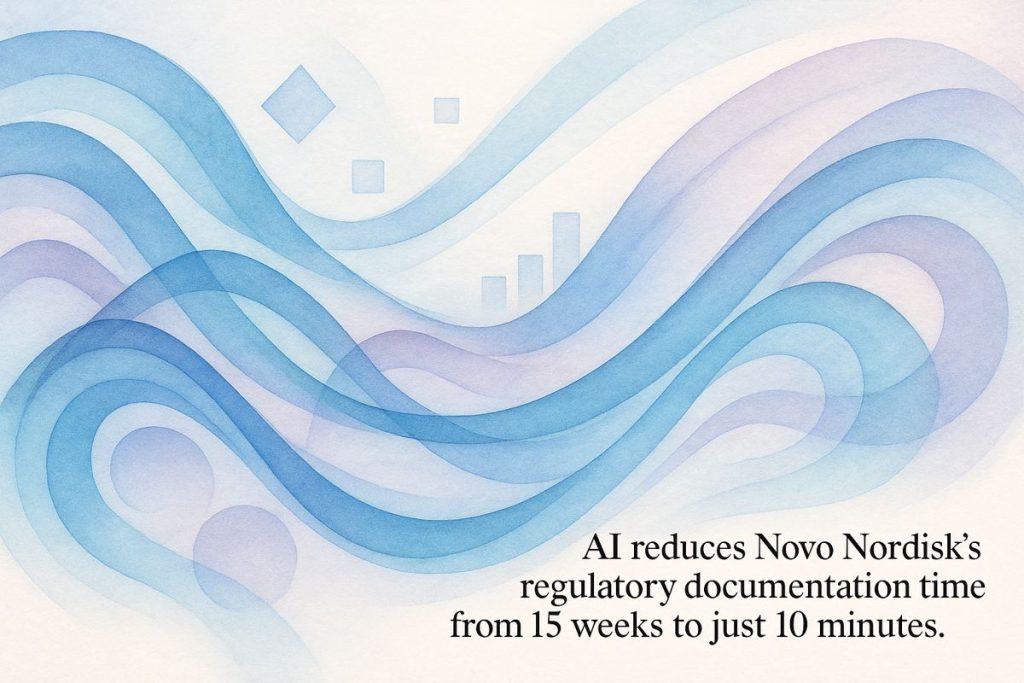Novo Nordisk has started using advanced AI, like Claude 3.5, to handle the huge piles of paperwork needed for drug approvals. What used to take a team months now takes minutes, turning boring, slow tasks into quick and almost graceful work. Workers aren’t losing their jobs—they’re getting to do smarter, more interesting things as the AI takes care of the dull stuff. Now, the company and its partners are dreaming even bigger with AI, hoping to speed up all parts of making new medicines. It’s like the quiet buzz of a machine at dawn, changing everything without anyone shouting about it.
How is Novo Nordisk using AI to transform pharmaceutical regulatory paperwork?
Novo Nordisk uses advanced AI, especially Anthropic’s Claude 3.5, to automate and streamline pharmaceutical regulatory documentation. Tasks that previously took 15 weeks now take just 10 minutes, reducing manual effort, improving compliance, and allowing staff to focus on higher-level analysis rather than repetitive paperwork.
The Hum of Algorithms: A New Day in Pharma
There’s a peculiar kind of silence in a clinical documentation office at 7:03 a.m.—broken only by the keystrokes of a well-caffeinated team. Once upon a Monday, Novo Nordisk’s regulatory staff would have braced themselves for a Sisyphean 15-week uphill slog, drafting submission after submission, eyes glazed as if the EU Clinical Trials Register itself might leap off the screen and demand a coffee break. But then came the advent of AI—specifically, Anthropic’s Claude 3.5, a model that wields hyperspectral precision with the patience of a chess grandmaster.
Why now, you ask? I did, too. For years, the pharma zeitgeist tiptoed around AI, wary that a single misstep might incite a regulatory firestorm. Yet, by 2025, Novo Nordisk, propelled by the success of Ozempic and emboldened by a fleet of pilot projects, decided the time was ripe. After road-testing everything from Meta’s Llama to OpenAI’s ChatGPT, they installed Claude 3.5—a bit like choosing a Stradivarius from a room full of violins (though, full disclosure, I’ve never played one). Zaylan Associates Press Release
From Drudgery to Digital Ballet
Let’s not mince words: paperwork in pharma used to be glacial. Teams of 50 could wrestle with regulatory filings for over three months, pages stacking up like sediment in a corporate palimpsest. But with Claude 3.5 at the helm, those same tasks shrink to ten minutes—yes, ten—thanks to three sharp-eyed staffers and a latticework of retrieval-augmented generation (RAG). WarpNews: 15 Weeks to 10 Minutes
The process is as mesmerizing as watching a loom weave silk: the AI plucks definitions and regulatory boilerplate out of a curated database, threading each line with the consistency of a metronome. I remember my own brief stint in compliance, the ache in my wrists after hour six, and the odd comfort of highlighters and the scent of cheap printer ink. Now, with real-time human review layering on that crucial last check, the process is brisk and—dare I say—almost elegant.
Yet, I’d be remiss not to mention a pang of skepticism. Could a machine grasp the nuance of, say, Article 57 of the EMA guidelines? Turns out, with RAG underpinning every output, compliance is less a tightrope walk and more a well-lit promenade. If anything, the human reviewers—formerly paper-pushers, now document maestros—have become the last defense against entropy. OpenTools: AI Revolutionizes Pharma
People, Not Pink Slips: Rethinking the Workforce
Let’s get one thing straight: Novo Nordisk hasn’t sent droves of document specialists packing. Instead, the shift is subtler—the hiring pipeline for these roles is narrowing, but those on board now find their days richer with judgment calls and analytic challenges. The company, in a move that might seem counterintuitive, doubled down on upskilling. Staffers are now more like conductors than typists, overseeing the AI’s sonata, intervening only when the melody veers off-key.
It’s a strange mix of relief and nostalgia. I felt a flicker of envy when I read about Novo’s retooled workflow—gone are the days of dreading endless document revisions, replaced by the heady thrill of catching the one errant phrase a model might misplace. Have I ever missed a regulatory nuance? Once, disastrously, in 2018. But with the AI’s hyperspectral recall, that blunder seems almost quaint.
And the ripple effects are everywhere. Scientists now let AI parse dense PubMed digests, and sales teams quiz virtual assistants about incentive protocols while on the road—imagine the scent of a rain-slicked Danish highway, an iPad chiming with AI-generated guidance. Dataiku Community
The Horizon: Partnerships and the Industry’s Palimpsest
Novo Nordisk isn’t operating in a vacuum. Their recent alliance with NVIDIA hints at a future where AI agents embed themselves deep within the strata of drug discovery, automating not just paperwork but entire swathes of hypothesis testing and molecular modeling. The implications are seismic—each collaboration a fresh layer in the industry palimpsest, each breakthrough echoing through boardrooms from Bagsværd to Basel. Bio-IT World: NVIDIA Collaboration
One wonders—will other pharma titans follow suit, or will they cling to their old workflows out of habit or hubris? For now, Novo Nordisk’s transformation serves as both exemplum and challenge, the aroma of progress wafting through corridors once choked with paper. You can almost hear the faint mechanical purr of Claude 3.5 at dawn, the industry’s quiet revolution in full swing…
